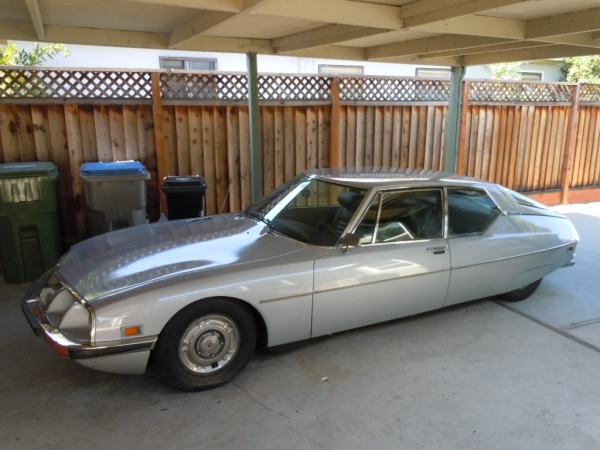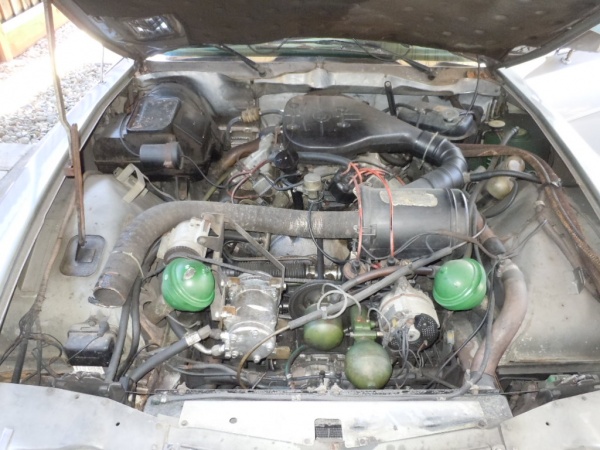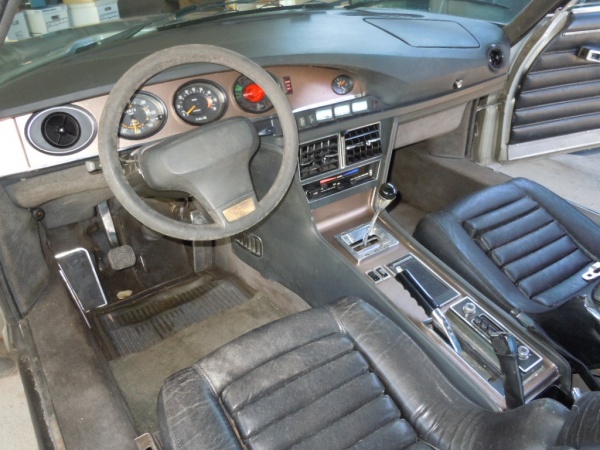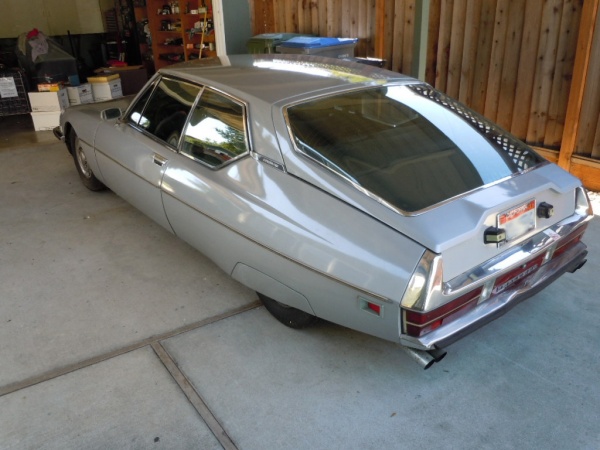
We are late finding this one, as the auction is ending in just 3 hours, but we had to feature it because Citroen SMs do not come along very often. With their quirky French styling and Maserati engine, there are few cars with more character. Find this one here on eBay out of San Jose, California with bidding at $11k.

That’s right, a Maserati V6 is powering the front wheels of this luxury cruiser. This particular car is claimed to only have had a couple of owners with the last one keeping it for 38 years. They racked up 69k miles, but over the years the car was replaced by modern machinery so it was left to sit in the garage.

Neglect caught up with this Citroen so the previous owner decided to part with it. The bad news is that it is not currently running and is going to need a lot of work to get back on the road. The good news is that it appears to be very original, even sporting its original paint. The interior looks decent and luckily this car is equipped with the five speed manual. Just pray that there are no major problems with that engine or hydraulic system. Notice the brake pedal.

They may not be everyone’s cup of tea, but we love ’em. They are very smooth riding grand tourers with enough power to keep up in traffic. There are plenty of specialists out there and most of the the major faults can be rectified. Be sure you really love them though before pulling the trigger because this one is going to need a lot of time and money. If done right though, the end result will be well worth it.
via eBay


Damn, this thing was for sale for $6000 a couple weeks ago on craigslist…
Looks like a dealer got to it first. Should have sent the link in so a fellow barn finder could have picked it up. Oh well…
No, a dealer did not get to it first. I had it on Craigslist and no local buyers came up, so I put the car on eBay. Simple as that.
Thanks for letting us know Serg. Looks like you did better listing it on ebay!
by the look of pic its an auto not 5 speed look at the pic of gear lever ”d” n and R anyway its sold and good luck to the new owner hope they enjoy
American models are all Auto with the larger engine than its European model and has different fixed lights euro model the lights turn with the steering!!!
Very strange to drive first off but great when used to them
Sold many at http://www.classics-cabriolets.co.uk
I have to disagree with you guys. The shift gate is just strange on these, which shouldn’t be a surprise. Plus, that is clearly a clutch pedal right next to the hydraulic brake button.
That is completely incorrect. US models came as auto and 5 speed. This car is a 5 speed.
The non-USA headlights have Cibie-Sekurit glass windshields, which can be installed over the USA round sealed beams.The outer low beams and the middle high beams do not steer with the front wheels. All six are connected to the suspension to keep the beams parallel to the road as the car pitches fore and aft.
They are connected with Rilsan tubes to the actuators. On the left fender, opposite the hood prop bracket, is seen a small bracket that, if the non-USA lights were equipped, the headlight damper is attached to so that the lights don’t bounce up and down with every little twitch of the suspension.
The fluid is not LHM but is a glycerine solution. It gradually weeps out over the years until the inner long range lights got “cross-eyed” and all six tilt down. Three adjustment barrels are provided to align the lights (also illegal in the USA) but once they run out of travel the tubes and actuators have to either be replaced or reset and refilled with the correct hydraulic solution.
The DSs with non_US lights had Cibie-Sekurit glass windshields (illegal in the USA after 1966). On Pallas models and as optional on lesser models, the inner long range lights were connected to the steering and all four lights were connected to the suspension to keep the beams parallel with the road. They were connected with Bowden cables (like bicycle gearshift and brake and motorcycle brake and throttle cables).
One country, Sweden I think, allowed only four headlights so two were blanked out.
LOL.. this car is not an automatic. It’s a 5 speed.
Having owned three 5 speed SMs, two 1972s and one ’73 3 litre, I can assure you that it’s a 5 speed. The auto does not have a clutch pedal. The Automatique’s selector lever is a paddle with a release button on the left side.
A decent 5 speed is worth thousand$ more than a decent Automatique.
This car is a manual. And it has a button for the brakes. Said button lies in the same location as a pedal would be, I’m no expert on these cars but said brake button was on of those quirks as was the suspension and if it was a euro model (I think) it would have been equipped with a single spoke steering wheel. Great driving car and when sorted, fairly reliable… I said when sorted, as sorting is quite expensive.
They all had the same steering wheel design. Both my USA and Euro-rest of the world cars had the same steering wheels. Different part nos. for the center pad but the look the same.
The “button” is easy to adapt to. Going back to a different car is the hard part. The Citroën hydraulic cars’ brake buttons and pedals are lower than the go pedal when the throttle is closed. No lifting the foot from the pedal, pulling you leg up before moving you foot over to the brake pedal/button. When switching to another car the foot tends to go under the brake pedal and get hung.
The first US models were 2.7 litre 5 speeds. The first Automatiques were 2.7 litre. For 1973 all were 3 litre 3 Webers. No Injection Electronique cars came to the US by the company. Any IE cars are private imports. From 1973 all Automatiques were carbureted 3 litres in all markets. They are to be avoided. To convert an Automatique to 5 speed is a massive undertaking requiring a complete donor car, like a wreck or rust-out, with all the parts. It is nice that the body-frames are the same. The steerings are about the only things that are different between the models that don’t need to be changed out as the Automatique steering gear just doesn’t have quite as much travel, so the car may have a slightly wider turn circle.
This car got notoriety to me in the movie “The longest yard” w/ Burt Reynolds when he gunned it in reverse and the backend lifted up a lot. Not my cup-of-tea though.
I had forgotten what a rat’s nest of hydraulic lines and tanks these things were. I’ve heard that finding parts for and repairing these things brings a new definition to the word “hassle.” I always thought they were interesting, bizarre, not exactly my kind of car, and very… well, French.
Almost all hydraulic lines are tucked away out of the way and pretty much out of sight. Unless you have a real rustbucket the pipes are steel and don’t go bad.
Modern cars’ ABS systems have more brake pipes than 1955 Chevies too. There’s only one hydraulic fluid reservoir. It’s the green thing in the left rear corner of the engine compartment. Make sure that green LHM is the only green stuff you pour into it. The system doesn’t like green antifreeze. Pentosin LHM is, the last I knew, the only LHM that is DOT approved for the US market. I have seen a few cans of Total here. May have been in the trunks of private imports when they came in? A few Canadian cars have been driven into the US and sold here. I had one. It was not sold, but abandoned. A real rustbucket. Broke in two. Salvaged the engine and many good parts for my other Ds.
The black tank in the left rear next to the LHM reservoir is the expansion tank for the cooling system. It’s where the Prestone goes. Make sure you never pour green LHM in it. Oil is not good for the radiator and heater hoses.
It sold for $11,200. Hopefully the next owner will keep us updated on their progress. It will be interesting to see how much work it actually needs.
These usually sell inexpensively over here for how exotic they are, mainly because there is a small market due to the general belief that they are prone to mechanical and hydraulic problems that take lots of $$$ and highly specialized knowledge to fix. There is also the idea that they are a quirky design.
On the other hand, people who have actually owned these cars have a very different view, and generally like them a lot. You don’t hear many reports supporting the assumption that they are prone to complex problems that require lots of $$$ to fix. Strangely, these cars are often the butt of jokes by people who have no experience with them. Too bad these interesting cars have such a bad rep over here. OTOH, that probably allowed someone to get a real buy on this car.
I owned a 1973 Citroen SM for 12 years in the same color combination, but with the larger USA-only carburrted 3.0L with 5spd manual. The Citroen mechanicals were never a problem. The Maserati engine and its internals were always a problem. Made a tough decision to sell, since my family owned a new 1973 Citroen SM (and it always had engine trouble) that I always believed was due to poor Citroen dealer knowledge/maintenance. Surprised this non-running SM went for so much money, with rust bubbling, too.
Look out for camshaft problems, scored pistons from sitting and then trying to start, dual igntion and point failure, improperly set timing chains (primary and two upper bank) and oil leaks.
If you live in California, Kentucky, or New York State, you have Citroen pros to save you and your car.
@ R1326
Sorry to hear that the Maserati engines in your cars were problematic, but it appears from your comment that questionable Citroen dealer service was a big factor in that. I guess maybe not all automotive takeovers automatically end up with the service being what it should be, especially when exotic Maser engines are involved.
I have heard SM owners say their cars were reliable, including the engines, but they tended to be in the big states on each coast—CA and NY—, which are the good states you mentioned for SM ownership. And it’s good to hear that your Citroen components were reliable.